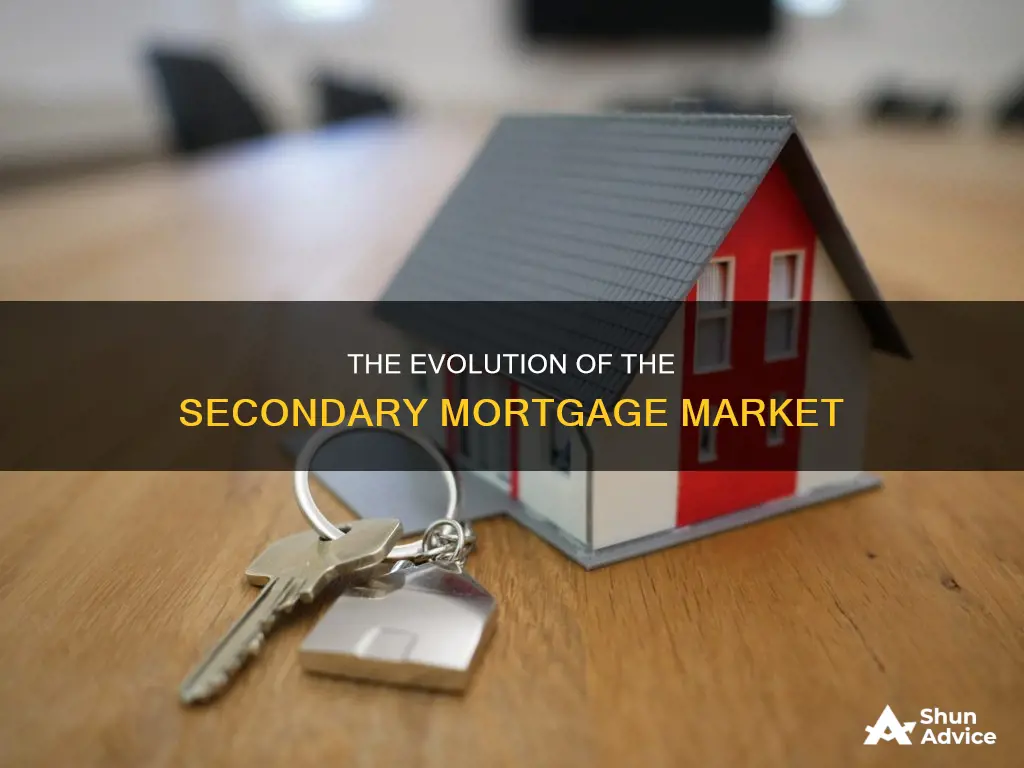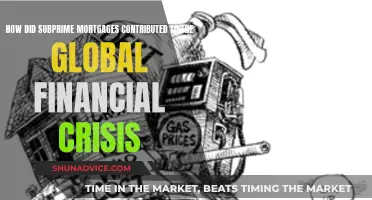
The secondary mortgage market is a financial marketplace where investors buy and sell bundled packages of individual loans, also known as mortgage-backed securities. The U.S. Congress created the secondary mortgage market in the 1930s to give lenders a bigger, steadier, and more evenly distributed stream of mortgage money to stabilize the nation's residential mortgage markets and expand affordable homeownership opportunities. The secondary mortgage market allows lenders to sell loans they've originated to investors, giving them more capital to lend to borrowers. This market is extremely large and liquid, making credit equally available to all borrowers across geographical locations and keeping mortgage rates lower.
| Characteristics | Values |
|---|---|
| Purpose | To make credit equally available to all borrowers across geographical locations |
| Established | 1930s |
| Benefits | Keeping mortgage rates lower, making mortgage loans with longer terms available to borrowers, allowing borrowers to refinance at any time without penalty |
| Players | Mortgage originators, mortgage aggregators (securitizers), and investors |
| Mortgage originators | Retail banks, mortgage bankers, and mortgage brokers |
| Mortgage bankers | Use a warehouse line of credit to fund loans |
| Mortgage aggregators | Purchase newly originated mortgages from smaller originators and form pools of mortgages that they securitize into mortgage-backed securities |
| Investors | Pension funds, insurance companies, and hedge funds |
What You'll Learn

The US Congress created the market to stabilise mortgage money
The secondary mortgage market is a financial marketplace where investors buy and sell bundled packages of individual loans, also known as mortgage-backed securities. The U.S. Congress created the secondary mortgage market in the 1930s to give lenders a bigger, steadier, and more evenly distributed stream of mortgage money. This market stabilised the nation's residential mortgage markets and expanded opportunities for homeownership and affordable rental housing.
Before the secondary market was established, only larger banks had the extensive funds necessary to provide funds for the life of a loan, which usually lasted 15 to 30 years. As a result, potential homebuyers struggled to find mortgage lenders, and higher interest rates were charged due to less competition between lenders. The secondary mortgage market was intended to provide a new source of capital for the market when the traditional source in one market, such as a Savings and Loan Association (S&L) or "thrift" in the United States, was unable to.
The secondary mortgage market is a continuous cycle involving trillions of dollars moving around the world from global investors to local lenders, to borrowers, and back again. It connects lenders, homebuyers, and investors from around the world in a single, efficient system that makes homeownership possible for millions of American families and renters. This market helps to make credit equally available to all borrowers across geographical locations. It also enables financial firms to specialise in various market areas, as lenders can slice up their mortgages and sell them on the secondary market while retaining the right to service the mortgage.
Several players participate in the secondary mortgage market, including mortgage originators, mortgage aggregators (securitizers), and investors. Mortgage originators consist of retail banks, mortgage bankers, and mortgage brokers. Mortgage bankers typically use a warehouse line of credit to fund loans, and most banks and nearly all mortgage bankers quickly sell newly originated mortgages into the secondary market. Mortgage aggregators are large mortgage originators with ties to Wall Street firms and government-sponsored enterprises (GSEs) such as Fannie Mae and Freddie Mac. Aggregators purchase newly originated mortgages from smaller originators and form pools of mortgages that they securitize into private-label mortgage-backed securities or agency mortgage-backed securities.
Mortgages: The Importance of Recent Financial Information
You may want to see also

Freddie Mac's role in the secondary mortgage market
The secondary mortgage market is a marketplace where home loans and servicing rights are bought and sold between lenders and investors. It allows loan issuers to continue funding more loans and helps make credit equally available to all borrowers across geographical locations. The U.S. Congress created the secondary mortgage market in the 1930s to give lenders a bigger, steadier, and more evenly distributed stream of mortgage money.
Freddie Mac, a government-sponsored enterprise, is a crucial part of the secondary mortgage market. Chartered by the U.S. Congress in 1970, Freddie Mac's role is to keep money flowing through the mortgage system during good and bad economic times. Freddie Mac buys mortgages and finances rental housing by charging management and guarantee fees and selling bonds to investors worldwide. It bundles mortgage payments with other mortgage payments and sends them to investors, with the income investors receive based on the principal amount and interest calculated on the mortgages.
Freddie Mac, along with Fannie Mae, buys residential mortgages on the secondary market and holds or sells them as mortgage-backed securities (MBS) to investors. These MBS are groups of loans known as collateralized mortgage obligations (CMOs) or mortgage-backed securities (MBS) that are sold to investors such as pension funds, insurance companies, and hedge funds. By purchasing mortgages on the secondary market and then pooling and selling them, Freddie Mac and Fannie Mae provide liquidity to the mortgage market.
Freddie Mac and Fannie Mae have faced challenges, including the 2008 subprime mortgage crisis and pandemic-era forbearances and moratoriums. These enterprises guaranteed a large majority of new residential mortgages originated in the United States and hold or guarantee about half of the outstanding residential mortgage debt. Policymakers are considering alternatives for the government's future role in the secondary mortgage market due to the cost to taxpayers of taking over these enterprises and their financial weaknesses.
Ruoff Mortgage Venue: Size, Capacity, and More
You may want to see also

The benefits of the secondary mortgage market
The secondary mortgage market has evolved into a large and liquid marketplace, offering several benefits to various economic players, including borrowers, investors, banks/lenders, and aggregators.
Benefits of the Secondary Mortgage Market:
- Increased Liquidity and Credit Availability: The secondary mortgage market provides liquidity to lenders, enabling them to replenish their funds by selling loans to investors. This liquidity allows lenders to continue offering financing to borrowers, making credit more readily available across different geographical locations. It also helps stabilize the mortgage market by providing a steady stream of mortgage money.
- Lower Mortgage Rates: The existence of the secondary market helps keep mortgage rates lower for borrowers. Before the secondary market, larger banks dominated the mortgage lending landscape, often charging higher interest rates due to limited competition. The secondary market introduces more players and competition, driving down interest rates and making homeownership more affordable for qualified borrowers.
- Longer Loan Terms: The secondary mortgage market facilitates the availability of longer-term loans, typically ranging from 15 to 30 years. This extended repayment period makes mortgage loans more accessible and manageable for borrowers.
- Refinancing Options: Borrowers often have the flexibility to refinance their mortgages at any time without penalty. This option allows them to take advantage of changing market conditions and potentially secure better terms for their loans.
- Specialization for Financial Firms: The secondary market enables financial firms to specialize in specific market areas. For example, a bank can originate a loan and then sell it on the secondary market while retaining the right to service the mortgage, allowing for a more efficient division of labour and risk management.
- Risk Mitigation for Lenders: Selling mortgages on the secondary market helps lenders mitigate risk. By distributing loans to various investors, lenders reduce their exposure to potential losses due to interest rate shifts and credit risk. This risk distribution contributes to a more stable lending environment.
Understanding Mortgage Amortization: A Complete Guide to Tables
You may want to see also

The risks of the secondary mortgage market
The secondary mortgage market is a marketplace where home loans and servicing rights are bought and sold between lenders and investors. It is a large and liquid market that helps make credit equally available to borrowers across geographical locations. The market allows loan issuers to continue funding more loans and keeps mortgage rates lower.
However, the secondary mortgage market is not without its risks. Here are some of the key risks associated with it:
- Risk of default: The secondary mortgage market is exposed to the risk of widespread mortgage default, as witnessed during the 2008 mortgage crisis. In the lead-up to the crisis, lenders issued high-risk loans to borrowers without properly assessing their ability to repay. This resulted in a significant increase in loan defaults and foreclosures, causing financial instability for banks and other financial institutions.
- Credit risk: Competition and risk are inherent in the secondary mortgage market when private investors are involved. Investors assess borrowers' credit scores, and those with low credit scores may be perceived as risky, leading to higher interest rates and fees.
- Liquidity risk: While the secondary mortgage market provides liquidity to lenders, allowing them to replenish their funds and offer more loans, there is a risk of reduced liquidity in the market. If investors lose confidence in the market or become risk-averse, they may withdraw their capital, leading to a decrease in available funds for lenders to originate new loans.
- Systemic risk: The interconnectedness of the secondary mortgage market means that a failure in one part of the market can have a domino effect on other participants. For example, during the 2008 mortgage crisis, the high number of loan defaults not only affected individual lenders but also impacted the stability of financial institutions, leading to government intervention to stabilise the market.
- Interest rate risk: The secondary mortgage market can be influenced by changes in interest rates. When interest rates rise, borrowers may struggle to keep up with their mortgage payments, potentially leading to an increase in loan defaults. Additionally, investors may be attracted to other investment opportunities with higher returns, reducing the pool of capital available in the secondary mortgage market.
- Regulatory risk: Changes in government regulations and policies can impact the secondary mortgage market. For example, new laws or guidelines affecting lending standards or investor protections can affect the availability of capital and the behaviour of market participants.
Avoiding Mortgage Crisis: Strategies for Stability and Security
You may want to see also

The major players in the secondary mortgage market
The secondary mortgage market is a financial marketplace where investors buy and sell bundled packages of individual loans, also known as mortgage-backed securities. The market emerged in the 1930s to provide lenders with a more significant, more stable, and evenly distributed source of mortgage money. This market has evolved to include several key players, each with distinct roles and contributions. Here are the major players in the secondary mortgage market:
Mortgage Originators
Mortgage originators are the first companies involved in the secondary mortgage market. They consist of retail banks, mortgage bankers, and mortgage brokers. Banks use their funds to close loans, while mortgage bankers typically employ a warehouse line of credit. Mortgage originators create the loans and then sell them on the secondary market to replenish their funds and continue lending. They may aggregate mortgages before selling them to manage the risk associated with interest rate fluctuations.
Aggregators
Aggregators are large mortgage originators with connections to Wall Street firms and government-sponsored enterprises (GSEs). They purchase mortgages from smaller originators and pool them with their own originations. These pools of mortgages are then securitized and sold to securities dealers, who further package and sell them to investors. Aggregators profit from the difference in the prices they pay for mortgages and the price they can sell the securitized pools for.
Investors
Investors are a crucial component of the secondary mortgage market. They purchase the securitized mortgage pools, which are known as mortgage-backed securities (MBS). These investors can be pension funds, insurance companies, or hedge funds. Investors do not control the mortgages but receive the interest income from borrowers' repayments. They see mortgages as a stream of future cash flows and participate in buying, selling, and securitizing these cash flows in the secondary market.
Government-Sponsored Enterprises (GSEs)
Government-sponsored enterprises, such as Fannie Mae and Freddie Mac, play a significant role in the secondary mortgage market. They work with aggregators to form agency mortgage-backed securities. Freddie Mac, for example, helps maintain a stable and consistent source of mortgage funding by bundling mortgage payments and sending them to investors. GSEs support the flow of money through the mortgage system, contributing to the stability of the housing market.
Securities Dealers
Securities dealers are often Wall Street brokerage firms that purchase the mortgage-backed securities (MBS) from aggregators. They further package these securities in various ways to cater to different types of investors. Securities dealers facilitate the distribution of the MBS to a diverse range of investors, ensuring the liquidity and accessibility of the secondary mortgage market.
Mortgages: From Stability to Junk in a Few Easy Steps
You may want to see also
Frequently asked questions
The secondary mortgage market is a financial marketplace where investors buy and sell bundled packages consisting of many individual loans, also called mortgage-backed securities.
The U.S. Congress created the secondary mortgage market in the 1930s to give lenders a bigger, steadier, and more evenly distributed stream of mortgage money to stabilize the nation's residential mortgage markets and expand opportunities for homeownership and affordable rental housing.
The four types of mortgage market players include mortgage originators, mortgage aggregators (securitizers), investors, and rating agencies.
Mortgage lenders originate loans and then place them for sale on the secondary market. Investors who purchase those loans receive the right to collect the money owed.







